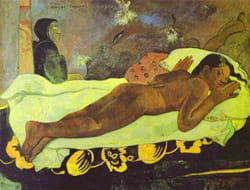 |
| Paul Gauguin, Manao Tupapao (Spirit of the Dead Watching, 1891. Albright-Knox Art Gallery Buffalo, New York. Public domain.) |
There are two prevalent sexual myths abroad in Western culture. The first myth (let's call it "hypocritical monogamy" or HM, exemplified by Arnold Schwarzenegger, Al Gore, Jesse Jackson, Eliot Spitzer, John F. Kennedy...I could go on) is of the seemingly monogamous marital relationship, a veneer under which there seethes raw natural drives which must be secretly released. Some will suggest that it is nature which makes monogamy a lie, an unnatural straightjacketing of sex.
The other myth ("sex positive" or SP, exemplified by Hugh Hefner, Madonna, Dan Savage, the Marquis de Sade, Alfred Kinsey, and Carol Queen) is of a world of complete freedom, self-discovery, and pleasure unencumbered by false social expectations.
Both myths operate under a common unproven assumption: that sex is just there, like orgone energy or something, and it simply must escape if people are not going to explode! HM is about going along with a repressive social construct rooted in Christian tradition! SP proposes to liberate people from HM to experience a beautiful world full of pleasure without negative consequences.
One reason why the SP myth is so wrong is because it is a response to an equally wrong HM myth.
There is no evidence to support the idea that people must release sexual feelings at all costs. This idea, which I'll call the Catharsis Hypothesis, looks only at outcomes: infidelities, sexual liaisons, hypocritical behavior after vows of fidelity. Clearly these temptations are as old as history, and are destructive of relationships. Ancient Israel, Babylon, Crete, India, Rome, and many other nations created laws to restrict such choices, making them subject to law. Ancient peoples were very aware of sexual license and the injury it did to children, families, and societies. Marriage laws, interestingly, amounted to a kind of proto-feminism, reducing the likelihood of predatory activity by men. They were imperfect, favoring men, but what is remarkable is that they nevertheless aimed at the restraint of male sexual drive by promoting lawful marriage and childbearing, and punishing adultery and other forms of nonmarital sex.
Various forms of revolt against sexual mores are not unique to modernity. What is new is the speed of the modern sexual revolution, as is the speed at which distressing social indicators like sexually transmitted infections, childbirth out of wedlock, abortion, sex trafficking [opens a PDF], and others have grown, and the intellectual gymnastics it takes to disassociate these indicators from the conviction that societies thrive when marriage is the promoted context for sex.





